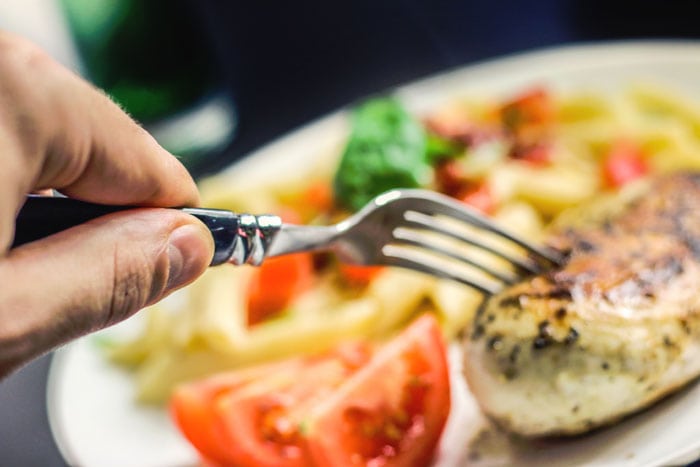
Written By: Elizabeth Daeninck, MS, RD
Title: Registered Dietitian
Alumni: Colorado State University
Last Updated on:

Everyone loves Sunday brunch! Instead of eating cold cereal with milk like you do on weekdays, you can finally eat some “real” breakfast (as my husband calls it). I recently had Sunday brunch at a popular breakfast chain restaurant, which gave me an opportunity to “rate my plate.”
First, I was served a large banana nut muffin with a glass of orange juice (before my “real” meal came). Well, as you can imagine, it was close to noon, and I had not had much to eat at home (just a coffee and a piece of toast). I was hungry so I quickly ate the whole muffin and drank most of the large glass of orange juice.

Not long after that, my meal was brought to the table. I had a Country Omelet with a plate of hash browns, plus a stack of 3 pancakes. Does this sound like a common breakfast? Yes. But a balanced meal? No way!
Table of Contents
Total recommended daily calorie intakes vary depending on a person’s body size, age, gender and activity level, but a typical goal is 2000 kcal per day (which is what you will see on a food label). This breakfast turns out to be almost 25% more than what an average person needs in a whole day!
So, what should you do when you are faced with a menu full of items similar to those described above? Here are a few ideas to help you in rebalancing your plate to bring down the calorie content of your meal while providing more reasonable amounts of nutrients.
Juice is a concentrated source of carbohydrates and calories. By opting for a fruit rather than the juice, you save on calories and carbs while increasing the fiber content of your meal.
If you feel you cannot skip the muffin, split it with someone. The large muffins most commonly served in restaurants are loaded with fat and carbs, which add up to unnecessary calories.
When looking over the menu, consider what your plate will look like with hash browns, pancakes and eggs. Try to decide which of the two carbohydrate-rich foods you would like to eat. Make a choice to eat only one carbohydrate option instead of three. (A muffin, hash browns, and pancakes make up the equivalent of over 6 slices of bread, adding up to over 800 calories from carbohydrates alone!)
If you are excessively hungry before you get to the restaurant, you are setting yourself up to have a bigger meal. Consider having a healthy snack before you go if you are very hungry so that you do not end up making poor choices once faced with a menu.
If you know where you will be dining for Sunday brunch, why not look up the menu online and choose what you will eat ahead of time? This way, you have better control to make a healthier choice, so you won’t be tempted by the variety of options presented on the menu at the restaurant when you’re really hungry.
Many restaurants will offer lower fat versions of a selection of their menu items. Consider ordering egg whites or egg substitutes to cut down on fat. Sharing your muffin, hash browns, pancakes and omelet with a friend will help cut the fat in your meal while giving you the opportunity to have a “taste” of all items.
When having breakfast or brunch out, re-balance your plate by seeing to it that you have protein, starches, and fruits/vegetables represented. Most commonly (as described above), there is an excessive amount of carbohydrates and fat with little or no fruit or vegetables, often with sufficient protein. Consider ordering from the heart healthy/low fat options and substituting fresh fruits for some of the starchy foods offered in your meal. For added nutrition impact focus in on the meals that offer eggs with a variety of vegetables.
Typically, it is recommended that a diet consist of 50-65% calories from carbohydrates, 20-25% from fat and 15-20% from protein.
Alumni: Colorado State University – Elizabeth Daeninck is a Registered Dietitian with a master’s degree in Exercise Physiology and Nutrition. She has taught classes at the college level and facilitated weight loss group meetings, presented a variety of nutrition seminars and is a published author and researcher in the field of nutrition.
breakfast, brunch, healthy dine-out